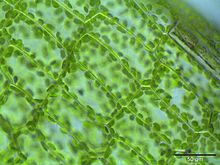Cytoplasmic streaming, also called protoplasmic streaming and cyclosis, is the flow of the cytoplasm inside the cell, driven by forces from the cytoskeleton.[1] It is likely that its function is, at least in part, to speed up the transport of molecules and organelles around the cell. It is usually observed in large plant and animal cells, greater than approximately 0.1 mm[vague]. In smaller cells, the diffusion of molecules is more rapid, but diffusion slows as the size of the cell increases, so larger cells may need cytoplasmic streaming for efficient function.[1]
The green alga genus Chara possesses some very large cells, up to 10 cm in length,[2]and cytoplasmic streaming has been studied in these large cells.[3]
Cytoplasmic streaming is strongly dependent upon intracellular pH and temperature. It has been observed that the effect of temperature on cytoplasmic streaming created linear variance and dependence at different high temperatures in comparison to low temperatures.[4] This process is complicated, with temperature alterations in the system increasing its efficiency, with other factors such as the transport of ions across the membrane being simultaneously affected. This is due to cells homeostasis depending upon active transport which may be affected at some critical temperatures.
In plant cells, chloroplasts may be moved around with the stream, possibly to a position of optimum light absorption for photosynthesis. The rate of motion is usually affected by light exposure, temperature, and pH levels.
The optimal pH at which cytoplasmic streaming is highest, is achieved at neutral pH and decreases at both low and high pH.
The flow of cytoplasm may be stopped by:
- Adding Lugol's iodine solution
- Adding Cytochalasin D (dissolved in dimethyl sulfoxide)

No comments:
Post a Comment